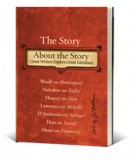Every Thursday on the blog brings a post about a paperback book.
 In his introduction to The Story About the Story: Great Writers Explore Great Literature
In his introduction to The Story About the Story: Great Writers Explore Great Literature, J. C. Hallman, who edited the collection, writes about “a kind of personal literary analysis, criticism that contemplates rather than argues. . . .” Examples of that brand of analysis are what Hallman has gathered here, and the collection is a treat even if its larger organizing principle might have been better left unstated.
Hallman’s brief intro scratches the surface of a larger, more bitter battle between academic and popular criticism. And unsurprisingly, that battle has been joined online. This comments thread at The Valve manages to be thoughtful and productive for a while before devolving into a more typical, repetitive Internet tussle.
In an essay included here about Walter Pater, Oscar Wilde writes:
. . . where there is no exaggeration there is no love, and where there is no love there is no understanding. It is only about things that do not interest one, that one can give a really unbiassed opinion; and this is no doubt the reason why an unbiassed opinion is always absolutely valueless.
Many of these pieces reflect that judgment, serving as very personal testaments to the power of certain works. In this vein, Salman Rushdie writes about The Wizard of Oz; Walter Kirn describes trying to meet The Catcher in the Rye “out in the open,” away from what he’s been taught to think about it; and Dagoberto Gilb uses his mother’s relationships as a way of understanding Cormac McCarthy’s Border Trilogy, offering smart, aphoristic insights about the characters in those three novels. (“They’re believers in these personal religions that we all really know deep down.”)
It still seems that the collection needn’t be posited against a more academic form of investigation. One can read this book and still believe in the necessity of a slightly different approach — not a theoretical, jargon-larded one, but simply a more consciously instructive one. Randall Jarrell’s “The Humble Animal,” an appreciation of Marianne Moore’s poetry, makes many sweeping (sometimes obscure) pronouncements about the subject but never really gets specific. It passes along an enthusiasm, but it doesn’t teach us anything. Cynthia Ozick’s piece about Truman Capote includes some fantastic descriptions of the author — “like an old caricature of Aeolus, the puff-cheeked little god of wind . . . his tongue on his lip like a soft fly.” But Ozick’s argument about why Capote’s first novel, Other Voices, Other Rooms, is a “dead and empty book” seems unnecessarily tortured. Ozick’s voice and natural gifts make up for a lot (I think I’ll always have that “soft fly” in the Capote corner of my mind now), but it’s not an essay I would teach in a criticism class.
But any arguments about the source or role of criticism are beside the point. With the heavyweights included here — Nabokov’s extended analysis of The Metamorphosis by Kafka, Susan Sontag on Dostoevsky, Albert Camus on Herman Melville — The Story About the Story doesn’t have to win any arguments to justify its existence.

